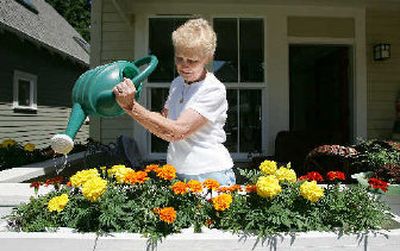Neighborhoods are a new cottage industry

KIRKLAND, Wash. — Joan Voves sold her 1925 Craftsman bungalow in a sought-after neighborhood after million-dollar mansions replaced smaller houses on three sides.
She never saw her new neighbors or their children, the 70-year-old Voves recalls.
When she moved into a cottage-style home in Kirkland, Wash., across Lake Washington from Seattle, she gave away her lawnmower, planted marigolds and began to meet people again.
“This is different, more neighborly,” she said. “This is what I was looking for.”
Voves moved into one of two “innovative housing demonstration projects” in Kirkland intended to test the public’s appetite for developments other than traditional large homes on suburban lots.
Kirkland residents will be asked this fall whether such nontraditional housing should be allowed in neighborhoods across the city.
One of those projects, Danielson Grove, includes 16 energy-efficient cottage-style homes, each with a small private yard arranged around a commons. Parking is a short walk away.
The other, Kirkland Bungalows, features 15 cottage-style homes along one side of a curving street, with attached one-car garages and open space in front and back.
After just one visit, Sharon Prescutti decided a Kirkland Bungalow was the condo alternative she was seeking.
Now a six-week resident, she still enjoys the look and the architecture.
“It’s just a small, perfect little house for me,” she said.
Not all residents are retired widows, however.
David and Monique Visintainer traded a nearly 100-year-old house in Seattle for a new home in Danielson Grove to escape urban crime, live near their Microsoft jobs and prepare for their first child, due next month.
By avoiding a 3,000-square-foot house, they’re more likely to “hang out with each other,” Visintainer said. They like the homes’ craftsmanship and believe the community will attract neighbors with a similar “lifestyle focus on quality versus quantity.”
Newlywed professionals Rebecca Leslie and her husband picked Kirkland Bungalows for its sustainable design and small lots with common areas that provide more open space than traditional developments.
The house “is only 1,500 square feet, but they really utilize the space,” she said.
At $385,000 to $610,000 for Danielson Grove and $445,000-$490,000 for Kirkland Bungalows, this is not “capital-A affordable housing,” said Linda Pruitt, one owner of The Cottage Company. But it’s more affordable than “dry-wall boxes” on standard lots nearby that cost $700,000 and up, she said.
The demand for nontraditional homes has been strong, with all but two Kirkland Bungalows sold since April. CamWest is building a larger King County demonstration project in the Renton Highlands, said Carolyn Gladwell, vice president of sales and marketing.
The Cottage Company has sold six of the Danielson Grove homes since May.
Among the reasons: More than half of U.S. households contain two people or less, according to 2000 Census data. That realization prompted Kirkland officials two years ago to seek ways of encouraging housing that fits into existing communities but is designed for singles, professionals, single parents, empty nesters and others.
Dianna Broadie, a member of the Kirkland Heritage Society, toured diverse housing in June with other representatives of the Highlands neighborhood. She considers the developments a promising way to retain one of Highland’s best features — an eclectic mix of housing sizes, styles and inhabitants.
“One thing that kind of housing maintains is a blend of different ages,” Broadie said. “Really large subdivisions … usually don’t.”
The city also required its demonstration projects to include “elements that contribute to a sense of community,” including front porches, common space and community centers. In return, the city provided flexibility on lot size, parking spaces and other requirements.
Some neighbors object to that urban-like density alongside larger lots, said Bungalows resident Leslie. But others appreciate the goal.
Sharon Brown and Phyllis Easterlin, who live on large lots several blocks away, recently strolled through both and liked what they saw.
“There’s only so much land,” Brown said. “God’s not producing any more.”
“I like the community feel here,” Easterlin said. “You could leave it, and people would watch after your house.”
If Voves gets to the point she can’t climb the stairs, she can move into the downstairs bedroom, she said. “I think I can stay here a very long time and be completely happy.”